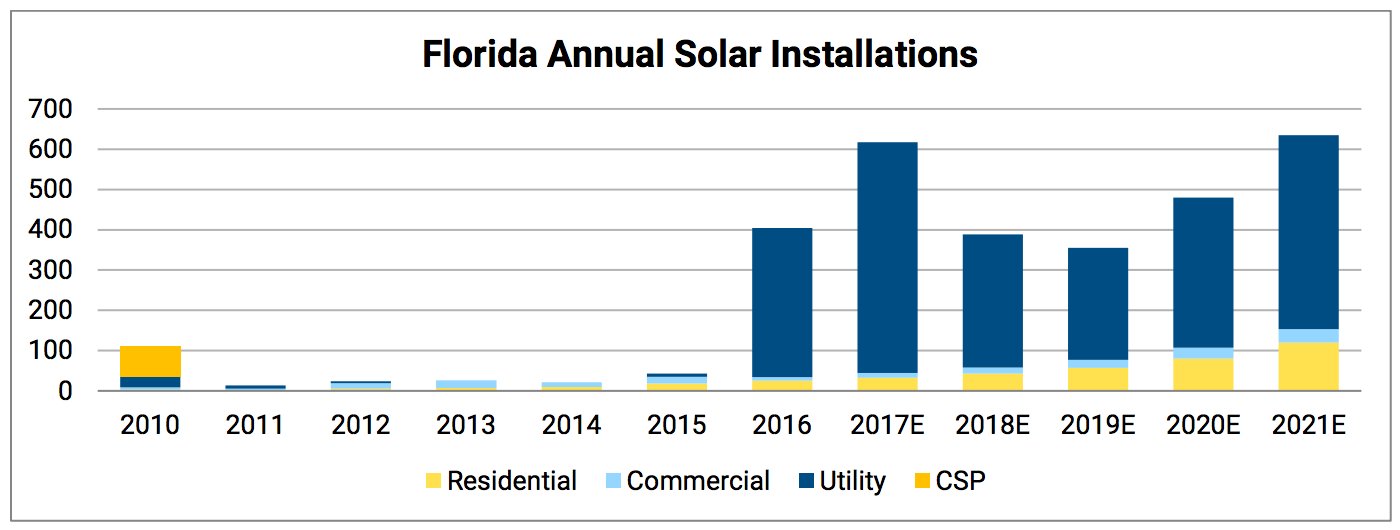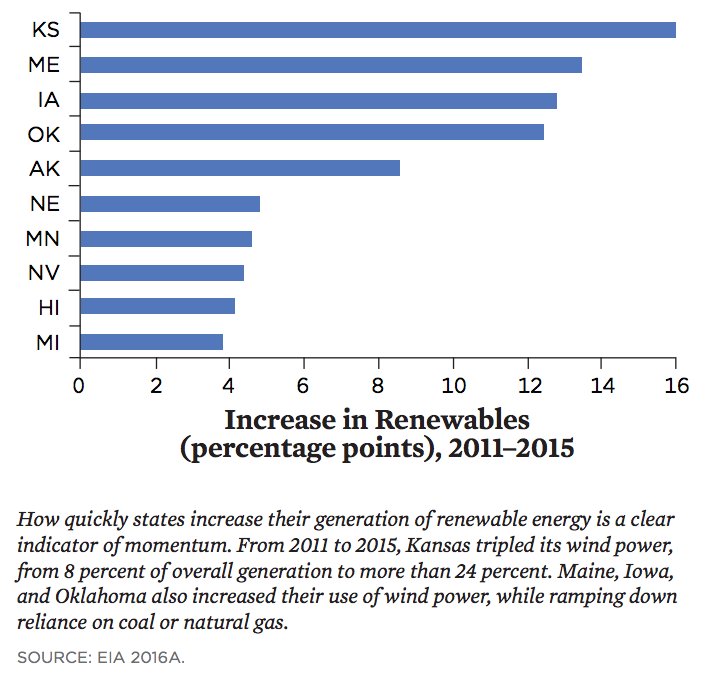Florida is the golden goose of the solar industry. The Sunshine State ranks third in the nation for rooftop solar potential, but just 12th for cumulative installed solar capacity -- which is why solar advocates are paying exceptionally close attention to policy developments there.
There is no renewable portfolio standard in Florida, and the state does not allow power-purchase agreements, which recently sparked a long and brutal campaign between two dueling ballot initiatives. In the end, the pro-PPA measure failed before making it on the ballot and a utility-backed amendment that sought to put restrictions on the solar market was voted down. It’s been a mixed bag for solar supporters with no tangible change. But now, after months of working closely with state legislators, solar supporters are enjoying a small win.
Earlier this week, Amendment 4, a pro-solar tax abatement proposal, was passed unanimously by the Florida House Commerce Committee. Amendment 4 was the third solar measure to be debated in the state last year, and it was approved by 73 percent of Florida voters last August.
Passing on the ballot was just the first step. The proposal specifically authorized the state legislature to exempt residential and commercial solar projects from both the tangible personal property tax and the ad valorem real estate taxes, but it did not approve the tax exemptions outright. Seven months after passing on the ballot -- in a testament to how slow the policy process can be -- Amendment 4 is now making its way through the state legislature and has successfully passed the first few hurdles.
An amendment filed by State Representative Ray Rodrigues helped to move the bill (HB 1351) out of the House Commerce Committee. The new language added consumer safeguards, including disclosures on the type of agreement customers are entering into, as well as any federal or state tax incentives the developer is relying on and a description of the assumptions used when pricing the solar system. The bill also requires that developers must comply with specific safety standards.
“The Solar Energy Industries Association (SEIA) applauds the initiative of House Majority Leader Ray Rodrigues on House Bill 1351, which protects Floridians by providing them with the critical information they need to make smart decisions when considering solar,” said Tom Kimbis, executive vice president of the SEIA. “By building off SEIA’s suite of consumer protection materials, policymakers, advocates and consumers will better understand solar transactions. We look forward to continued collaboration between the solar industry and state leaders as Florida adopts helpful consumer protection disclosures that can serve as a model throughout the nation.”
Kimbis’ statement points to an ongoing issue in the solar sector, where critics say companies are not doing enough to protect consumers from bad practices. Last month, SEIA launched a nationwide consumer education campaign and “protection portal.” Solar transaction disclosures are now also available online.
“Today, we took a big step toward passing solar legislation in the House Commerce Committee that will protect Floridians and enact the will of the voters of Amendment 4,” said Florida House Majority Leader Rodrigues. “House Bill 1351 is largely supported by the solar industry and will allow for proper consumer protections, as well as tax exemptions.”
Amendment 4 is also moving forward in the Senate. On April 13, companion bill SB 90 passed the Senate Appropriations Subcommittee on Finance and Tax, and it was heard by the Senate Appropriations Committee this week. If signed into law, the solar tax breaks will take effect in 2018 and could dramatically boost the Sunshine State's commercial deployment numbers.

Oklahoma brings its tax credit to an early end
Governor Mary Fallin signed legislation on Monday that brings an end to the state’s wind energy tax credit nearly three years early. House Bill 2298 sunsets the zero-emissions tax credit for new wind projects on July 1. The incentive was originally scheduled to end on Jan. 1, 2021. Projects that still qualify will receive an incentive worth 0.5 cents per kilowatt-hour for up to 10 years.
The incentive created a boom in the Oklahoma wind industry -- the state now ranks third in the nation for total installed wind capacity, with nearly 7,000 megawatts in the ground. Wind currently makes up 25 percent of Oklahoma’s energy mix. But as wind generation has increased, offering the tax credit has become expensive.
In the 2014 tax year (the last year for which data is available), Oklahoma paid out nearly $60 million in zero-emission rebates, according to the Oklahoma Tax Commission. For comparison, the state paid $18 million in rebates in 2012.
Supporters of HB 2298 said ending the tax credit early was prudent given that the state is facing a $870 million budget shortfall, and will save the state $500 million over the next 10 years.
“This bill will save the state a significant amount of money moving forward, freeing up revenue that can be used on high priorities like education, public safety and health care,” said Senate President Pro Tem Mike Schulz (R), who sponsored the bill. He also said “accelerating the end date of the wind-energy tax credit provides certainty for the industry.”
The wind industry disagrees. While acknowledging the state’s budget woes, some wind companies pointed out that the change hurts developers who already have projects under construction, but won’t have them operational by July 1. The Rock Falls wind farm in northern Oklahoma, for instance, stands to lose millions of dollars, Virinder Singh, director of regulatory and legislative affairs for EDF Renewable Energy, told NPR.
Renewable energy advocates have also criticized the bill, noting that fossil fuel industries have long received significant subsidies and continue to do so. Reuters reports that Oklahoma oil and gas companies received a $470 million tax break in 2015 alone. In 2014, Gov. Fallin signed into law a permanent, lowered tax rate for oil and gas drilling companies in the state. Fossil fuel companies are Fallin's largest campaign contributors.
Washington, D.C. conducts a value-of-solar study
On April 12, the People's Counsel for the District of Columbia released the first-ever value-of-solar study on the potential for wide deployment of solar energy in D.C. The report found that solar deployments in the District grew from virtually nothing in 2009 to nearly 20 megawatts in 2016. And the technical potential for additional deployments is vast. The report determined that 85,000 small roofs and more than 100 million square feet of usable space on large rooftops could generate an additional 1,700 megawatts of solar power in the District -- 84 times more solar than what it currently has.
The study authors stated: "If policymakers, utilities, solar installers, and residents continue to work toward solar deployment, there is no doubt that the District can achieve its ambitious goal of generating 5 percent of all its electricity needs with local, distributed solar energy."
Furthermore, the deployment of distributed solar won’t hurt ratepayers, according to the study. The authors determined that “the value of solar to the utility system exceeds the cost, indicating that solar PV is a cost-effective electricity resource that also provides health and environmental benefits to society,” said Thomas Vitolo, senior associate at Synapse Energy Economics, which partnered with the People's Counsel on the report.
A separate report released this month, Solar Potential for Integration of Distributed Energy Resources in Low- and Medium-Income Communities, offered recommendations on how to expand access to solar in the District. The authors highlighted the need to build off-site community solar projects to serve residents who don’t have the roof space or the roof quality to install solar on-site. Both studies are available here.
Clean energy momentum in 50 states
It probably comes as no surprise that California topped the Union of Concerned Scientists’ ranking of states transitioning away from fossil fuels. The Golden State performed well on all metrics, from solar capacity, to energy savings, to ease of corporate renewable energy procurement, to carbon reduction targets.
Vermont ranked second for having the highest number of clean energy jobs per capita, as well as earning top scores in energy-efficiency policy and electric-vehicle adoption. Massachusetts grabbed third place for its strong energy-efficiency standard and robust residential solar market, among other things.
The leaderboard looks totally different when it comes to renewable energy generation, however. In 2015, the benchmark year for the UCS report, South Dakota led the pack on renewable energy as a percentage of all in-state electricity generation. Hydropower accounts for half of the state’s electricity, a proportion that has changed little for decades, but wind now represents more than a quarter of generation.
Washington, Idaho and Oregon rank high largely because of the large amount of hydropower in their energy mixes. But wind has also started to boom in these states.
In the ranking of renewable energy generation increase over time, Kansas topped the list for its growing use of wind power. “While the Sunflower State remains heavily connected to coal generation, it tripled its use of wind power from 2011 to 2015, both as a proportion of its generation, from 8 percent to more than 24 percent, and in absolute terms,” the report states. Maine, Iowa and Oklahoma come in next on the list, having all increased renewable energy generation by more than 10 percentage points between 2011 and 2015.
Renewable Energy Generation Increase, 2011-2015
